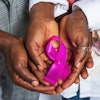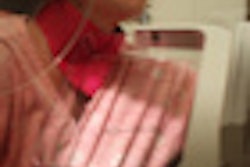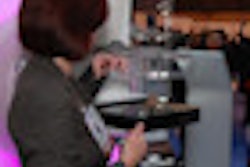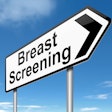CHICAGO - Do you remember the ruckus last year when television celebrity Dr. Mehmet Oz recommended on the "Dr. Oz Show" the use of thyroid shields during mammograms? While Oz appears to have changed his tune, social media continues to promote this misconception, according to an ASRT @ RSNA presentation at the RSNA meeting.
Radiologic technologists are the first -- and often the only -- radiology professionals to be confronted by misinformed women about the risks of having a mammogram, whether due to the "Oz effect" or other sources. Lynelle Tomiko Yutani, an instructor in medical radiography technology at Camosun College in Victoria, British Columbia, discussed the effects of media-driven health information on medical imaging and recommended strategies to mitigate incorrect information.
She particularly focused on the "Oz effect," a term coined by Forbes Magazine, which refers to the impact health information aired on television, distributed by social media, or issued by government agencies, along with the influence of media personalities, has on patients in Canada and the U.S. Many recipients of often biased, incomplete, or inaccurate information accept what they read at face value, especially if the information is "glamorized" by a national celebrity.
Incomplete reporting combined with conflicting messages from the media and quasi-expert sources creates a culture of confusion, she said. Social media, which is self-focused, creates an environment comparable to a protective cocoon, connecting like-minded people whose communication with each other reinforces the "validity" of the message.
When the message pertains to medical imaging, it can erode confidence, reduce compliance, and create an adversarial relationship for the imaging professional -- who, usually, is the technologist.
As a trusted television show host who also is a cardiothoracic surgeon and vice chair and professor of surgery at Columbia University, Oz's opinions are believed and acted upon. Yutani referenced a recommendation to use the Neti Pot, a nasal saline irrigation product. After Oz mentioned the Neti Pot, sales increased by 12,000%. Internet searches about the product increased by 42,000%.
Oz, mammograms, and thyroid shields
"Once Dr. Oz said that if he were a woman, he would always ask for a thyroid shield when he had a mammogram, the genie was out of the box," said Yutani.
The controversy began with a December 30, 2010, rerun of a thyroid cancer episode, which had originally aired a few months earlier. An anonymous email spread, in which a viewer said she just had a mammogram and requested the shield. It was in a drawer, she wrote, and when she asked the mammographer why it wasn't routinely used, she was told that patients needed to ask for it. "If I hadn't seen the show, how would I have known to ask?" she wrote.
The text went viral, appearing on numerous blog sites, email chains, and discussion boards. Today, a Google search of "mammogram and thyroid shield" yields about 224,000 results. Professional medical societies, consumer organizations promoting women's health, and other media responded to the misinformation. Under pressure from the American College of Radiology (ACR) and the Society of Breast Imaging (SBI), experts in breast imaging were invited to briefly state the facts.
"However, it hasn't done much good," Yutani said. "Radiographers must allay women's fears and concerns, and they must do it professionally, politely, convincingly, quickly, and without antagonizing the patient."
And if patients still want to wear a thyroid shield, and an exam requires a retake because of it, the technologists may be penalized for slowing workflow and performing exams of poor quality unless they document the request in the RIS or a patient's records.
More problems
"Other than for thyroid shield manufacturers -- you'll never believe how many are being made now as a result of an overwhelming demand for a practically nonexistent product -- Oz's pronouncement has caused problems for techs and the workflow efficiency of radiology departments," she said. An unknown number of women have had to undergo repeat exams, effectively doubling the radiation dose exposure they were so anxious to avoid.
The repeat rate in British Columbia spiked to 20%, a rate Yutani believes could be attributed to the use of thyroid shields. She also shared her own experiences dealing with thyroid shields when, for a period of time, she ran a mobile mammography van service.
"We visited areas of British Columbia where no mammography was offered," she said. "The system was analog. We rolled it out of the van and into a room. We changed cassettes inside a pop-up tent in a darkened room. As a result, we never saw if an image was ruined by a thyroid shield. And if it was, in all likelihood that patient would wait a full year until the van returned before she had another mammogram."
Yutani and her colleagues also faced a daily dilemma of how to sanitize a thyroid shield when there was heavy use. The van service averaged 60 exams per day, and in these tight-knit communities, if one woman wanted to use a thyroid shield, many of the other women did as well. The things fell apart.
Social media doesn't propagate factual, nonmelodramatic information, and when it does, the effect is not the same. Oz has never publicly stated that his advice was wrong, Yutani believes.
When visitors go to DoctorOz.com and search for "mammogram and thyroid shield" or "thyroid shield," they are directed to a page titled "Recommendations on Radiation," which begins: "If you or a loved one is concerned about radiation received to the thyroid from a mammogram, the American College of Radiology and the Society of Breast Imaging want you to know the following." A short explanation from ACR and SBI then follows.
Meanwhile, the misinformation continues to propagate. What should radiologic technologists do about it?
Always remain professional
Yutani, who moved to Canada six years ago, phrased her remarks in the context of dealing with Canadian women. She said that one of the most predominant traits she has noticed among Canadians was their largely nonconfrontational nature.
"Canadians usually feel guilty when they might be at fault," she said. "We play upon this, but we are also very honest." Regardless of the patient, a technologist needs to remember that he or she is providing a service, and the customer is always right. Technologists should always be friendly, patient, and positive, but they should also provide accurate information as a knowledgeable medical imaging professional.
When patients ask about a thyroid shield, they should be told the facts -- the "Recommendations on Radiation" on the Oz website is a great source -- without being confrontational, she said. If they insist, they should be reminded that a thyroid shield can make mammography images unusable, and if that is the case, the exam will need to be performed again, with a 100% increase in radiation dose exposure to the breast.
Yutani recommends that the patient be asked to sign a form stating that she has requested the shield, knows that a repeat exam may be needed, and knows that if the repeat scan is also damaged, another exam may be needed. At the same time, technologists should explain that the signed form will exempt them from a poor-quality exam rating and they will not be penalized regarding their repeat exam rate.
"In Canada, this statement may be more powerful than telling patients that the information they believe about radiation exposure to the thyroid from a mammogram is incorrect," she said. "I don't know if American women would react the same way."
As for calculating how many women have been negatively affected by the "Oz effect," there is no way to know. Retakes caused by thyroid shields in British Columbia, for example, are buried within retake statistical data. Nobody knows how many women skipped a screening mammogram.
Social media has not propagated a retraction of the myth of the thyroid shield and mammograms.
"We're living in a culture of confusion, glitz, and a lack of accountability," Yutani concluded. "Blogs that are ‘dull' and ‘factual' without also being dramatic don't go viral."



















